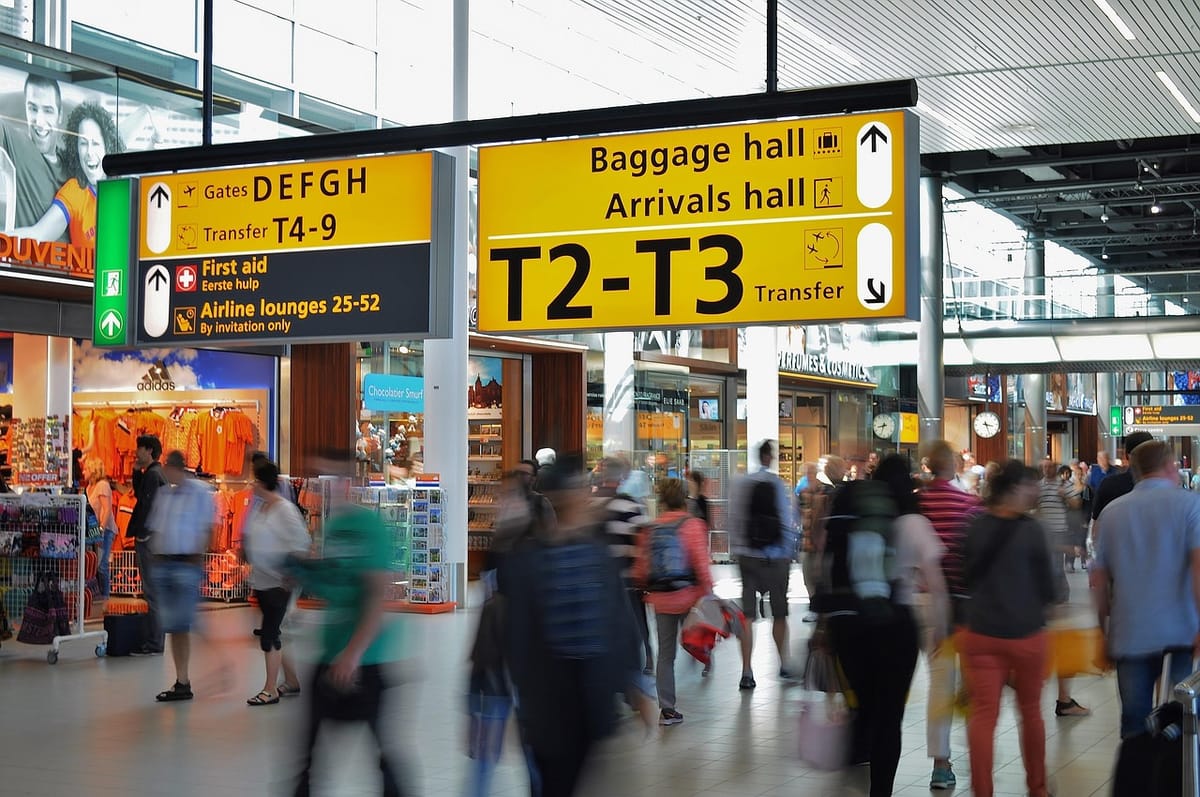US Air Force, DJI, FAA, Netherlands face aviation challenges

TL;DR
- U.S. Air Force delays F‑47 NGAD production, citing variable‑cycle jet engine supply chain problems that threaten first‑generation stealth fighter rollout.
- DJI faces U.S. market ban after FCC grant, with audit allegations heightening commercial drone uncertainty in domestic delivery sector.
- Heavy Thanksgiving travel forecasted; FAA preps 360,000 flights, urging crew readiness amid potential congestion and safety risks.
- Venezuelan flight cancellations spike as FAA warns pilots over heightened security, prompting airlines to halt routes to Caracas and Barinas.
- Dutch military neutralizes 11 drones over Volkel Air Base; incident escalates European surveillance tensions and signals increased NATO airspace threats.
Why the F‑47 NGAD’s Engine Bottleneck Delays America’s Next Stealth Fighter
Engine development lag
- GE XA102 and Pratt & Whitney XA103 variable‑cycle engines missed Q2 2026 design‑review milestones.
- Shortages of high‑temperature alloy forgings and limited additive‑manufacturing capacity pushed prototype qualification to Q4 2027.
- Risk assessment rates engine delivery “high” (>70 % probability of delay) for the FY 2027 production window.
Supply‑chain constraints
- Critical turbine‑blade blanks supplied by a single vendor reduced output by 15 % after the pandemic, delivering 1,200 blades annually versus the 2,400 required.
- New certification requirements for variable‑cycle components added 30 % lead time.
- Export‑control reviews triggered by Chinese prototype activity (J‑36, J‑50/XD) delayed material releases to U.S. manufacturers.
Schedule ripple effect
- Low‑rate production rollout shifted from Q4 2026 to Q4 2028.
- Initial operational capability moved from FY 2028 to FY 2030.
- NGAD entry‑into‑service now aligns with the Navy’s F/AXO fighter (FY 2029), compressing the inter‑service technology gap.
Cost escalation
- Unit cost projections rise 15‑20 % to $350 M–$380 M, driven by 12 % YoY increase in nickel‑based superalloy prices and added engineering hours.
- Total program envelope expands from $60 B to approximately $70 B for a 200‑aircraft fleet.
- Funding reallocation impacts the F‑35 “production run limited” and the Navy’s F‑22 reduction program, creating downstream sustainment pressure.
Industry response
- GE and Pratt & Whitney each announced $1.2 B investments in metal‑laser powder‑bed fusion capacity, targeting a 2027 ramp‑up.
- The engine market is consolidating toward fewer, larger suppliers to achieve economies of scale for high‑temperature components.
- GE Aerospace CEO formally requested a Pentagon export‑control waiver for critical raw materials to accelerate production.
Outlook 2026‑2028
- By Q2 2027, combined engine output should meet 80 % of low‑rate production needs, provided capacity expansions proceed as planned.
- The Air Force is likely to approve a revised unit‑cost ceiling of $380 M per aircraft in the FY 2028 budget amendment.
- NGAD fielding will overlap with the F‑35 Block 5 upgrade cycle, prompting joint sustainment planning for mission systems and logistics support.
DJI Ban Looms: What It Means for U.S. Delivery Drones
The Federal Communications Commission exercised retroactive ban authority in October 2025, adding DJI products to the FCC “Covered List.” This action expands the agency’s power to prohibit import and resale of equipment lacking explicit FCC authorization.
Audit status
The National Defense Authorization Act requires a national‑security audit of Chinese‑origin commercial drones, with a statutory deadline of 23 December 2025. DJI submitted audit requests to five agencies in September 2024 and followed up in March 2025, yet no agency has initiated the review.
Timeline of key events
- Sept 2024 – DJI’s initial audit request to FAA, DHS, DoD, CISA, FCC.
- Mar 2025 – Follow‑up letters to the same agencies.
- Oct 2025 – FCC grants retroactive ban authority; adds DJI to Covered List.
- Nov 2025 – DJI publishes public statement demanding audit completion.
- Dec 2025 – Legislative deadline for audit completion.
Market concentration and cost implications
- DJI and Autel Robotics hold ≈90 % of the U.S. commercial‑drone market.
- Florida’s emergency‑drone replacement program reports $200 M in functional DJI losses; budgeted $25 M for lower‑cost alternatives.
- Average operational cost per DJI unit (e.g., Mavic 3 Thermal) is $5.5 k; U.S.-made substitutes range $15‑20 k, a ≈200 % increase per unit.
- For a typical 200‑drone fleet, replacement costs rise from $1.1 M to $3‑4 M, implying a ≥30 % increase in total fleet operating expenses.
Impact on delivery operations
A ban would remove DJI units from service, forcing delivery firms to suspend drone‑based shipments or switch to ground logistics. Historical performance data suggest a 15‑20 % slowdown in delivery speed when drones are replaced by ground transport. Additional FCC authorizations for each alternative UAV could add 4‑6 weeks to rollout timelines.
Short‑term scenarios (≤ 6 months)
- Audit completed before 23 Dec 2025 – Low likelihood (≤ 20 %). DJI retains market access under conditional FCC approval.
- Audit not completed – High likelihood (≥ 80 %). FCC enforces the ban; delivery firms must transition to U.S. or allied‑nation UAVs.
- Partial exemption for emergency services – Moderate likelihood (≈ 30 %). Public‑safety fleets may retain DJI units; commercial delivery remains affected.
Strategic recommendations
- Accelerate engagement with federal agencies to trigger the mandated audit before the deadline.
- Develop procurement pipelines for U.S.-made UAVs (e.g., Skydio, Intel‑based platforms) to mitigate supply‑chain disruption.
- Perform lifecycle cost modeling that incorporates regulatory compliance expenses for alternative platforms.
- Establish dedicated compliance teams to manage FCC authorizations, reducing time‑to‑deployment for new UAV types.
Heavy Thanksgiving Travel Puts FAA to the Test
- Total scheduled commercial flights (Nov 23 – Dec 1): ≈ 360 000 – FAA press release
- Peak‑day schedule (Tue Nov 24): 52 000 + flights – FAA schedule data
- Baseline daily flights: ~30 000 – Historical FAA records
- Projected air passengers: ~6 million (‑2 % YoY) – AAA forecast
- Projected road passengers: ~73 million (≈ 90 % of total) – AAA forecast
- Shift to bus/train/cruise: +8.5 % – AAA forecast
- TSA Pre‑Check advisory: mandatory double‑check – TSA guidance
- Carry‑on liquid limit: 3.4 oz per container – TSA rule
What the Data Reveal
- More than 15 % of all flights concentrate within the two‑day Thanksgiving window, reproducing the highest traffic level of the past 15 years.
- FAA crew‑readiness alerts historically rise 51 % during peak holidays; a 0.8 % increase in delay minutes follows each 1 % rise in crew absenteeism.
- HPC traffic‑flow models forecast sector occupancy > 85 % for four consecutive hours on Nov 24 – a recognized precursor to reduced separation minima and higher loss‑of‑separation risk.
- Air‑travel volume dips 2 % YoY, while road trips add 1.6 million trips, easing overall system load but intensifying airport access road and parking demand.
- The recent 43‑day government shutdown trimmed flight slots by 5 %; its end restores full capacity, sharpening the net load spike.
Operational Risks
- Four en‑route sectors (NE, SE, MW, NW) will exceed nominal capacity; pre‑emptive activation of FAA Traffic Management Initiatives (TMIs) is essential.
- Crew duty periods must stay ≤ 14 hours. Historical fatigue incidents rise 12 % when limits are exceeded, indicating a need for additional standby crews at ATL, ORD, DFW.
- Gate turnaround times are projected to climb from 45 min to ≈ 55 min, likely propagating on‑ground delays without extra ground‑crew shifts.
- Enforcing the 3.4‑oz liquid limit and mandatory Pre‑Check verification can cut security‑line dwell times by ~18 %, reducing queue spill‑over.
Timeline (Nov 22 – Dec 2)
- 22 Nov (Mon): 30 k flights – baseline
- 23 Nov (Tue): 38 k flights – early peak, crew positioning
- 24 Nov (Wed): 52 k+ flights – sector saturation, gate delays
- 25 Nov (Thu, Thanksgiving): 47 k flights – passenger‑load spikes, security queues
- 26 Nov (Fri): 45 k flights – post‑holiday recovery, residual congestion
- 27‑30 Nov: 35‑40 k flights – normalization
- 1 Dec (Mon): 32 k flights – return to baseline
What Must Be Done
- Activate TMIs (Flow‑Control, Ground‑Stop) by 00 UTC on 24 Nov to keep sector occupancy ≤ 85 %.
- Expand crew standby pools at the top‑five hubs, targeting a 3 % availability margin.
- Deploy additional ground‑crew shifts at congested airports to maintain ≤ 50 min turnaround.
- Run a targeted public‑awareness campaign on liquid limits and Pre‑Check compliance.
- Monitor sector occupancy in real time via the FAA’s HPC platform and adjust TMIs dynamically.
Airlines Fly Blind: How the FAA Advisory Triggers a Rapid Collapse of Venezuelan Connectivity
Security Advisory Sparks Immediate Cancellations
On 23 Nov 2025 the FAA issued a security advisory labeling Venezuelan airspace “potentially hazardous.” Within hours six carriers—TAP, Iberia, LATAM, Avianca, Gol and Caribbean Airlines—announced suspension of all flights to Caracas and Barinas. The advisory also imposed a 72‑hour advance‑notice requirement for any overflight of Maiquetía, effectively forcing airlines to treat the warning as a binding operational directive.
Military Activity as the New Risk Metric
The advisory cites heightened U.S. military activity: the USS *Gerald R. Ford* carrier strike group, B‑52 bombers and anti‑drug operations operating in the Caribbean since September 2025. This kinetic presence has become the primary risk indicator for airlines, eclipsing traditional air‑traffic‑control concerns.
The Domino Effect on Regional Routes
- Direct connectivity to Venezuela from Europe, South America and the Caribbean is now severed.
- Airlines are forced to rely on hub‑and‑spoke models via Panama, Colombia or Brazil, adding at least 2–3 hours to flight time.
- The pattern mirrors the 2019 U.S. flight ban, suggesting an accelerating erosion of direct service.
Rising Cost Pressures
- War‑risk insurance premiums are expected to climb, reflecting the advisory’s threat classification.
- Extended routing increases fuel consumption, prompting higher fares or further route withdrawals.
- Compliance with the 72‑hour notice clause demands new risk‑assessment modules in flight‑planning software.
What the Next Six Months May Hold
- Continued cancellations: ≥ 70 % chance more carriers will suspend Venezuelan legs.
- Alternate corridors: ~50 % probability of formal “safe” overflight routes being adopted, raising operational costs.
- Regulatory escalation: ≤ 30 % chance the FAA advisory becomes binding for non‑U.S. airlines, potentially leading to a coordinated multilateral restriction.
- Partial restoration: ≤ 20 % chance of limited service return if U.S. military activity recedes and the advisory is lifted.
Monitoring U.S. military deployments and subsequent FAA communications will be essential for airlines, insurers and passengers navigating an increasingly volatile airspace over Venezuela.
The Growing Drone Threat Over Europe’s Skies
The Volkel Interception
- Date/Time: 22 Nov 2025, 19:00‑21:00 local
- Location: Volkel Air Base, Netherlands (≈ 40 km from Eindhoven Airport)
- UAS Count: 11 drones, all neutralised by ground‑based kinetic weapons
- Outcome: No wreckage recovered; air traffic at Eindhoven Airport temporarily suspended
- Royal Netherlands Air Force, Dutch police, NATO investigation cells
The operation relied on small‑calibre automatic fire rather than missile systems, highlighting a tactical shift toward low‑collateral‑damage solutions for low‑altitude threats.
Pattern Across the Continent
- Sep 2024 – Denmark & Norway: Drone sightings near civilian airports caused 2‑hour flight halts.
- Sep 2024 – Poland & Romania: Russian‑origin drones intercepted through coordinated air‑defence.
- Aug‑Oct 2024 – Estonia: Three unauthorized Russian jet incursions prompted NATO air‑policing.
- Nov 2025 – Ireland (Shannon): Vehicle breach of a restricted area, underscoring broader perimeter pressure.
Common threads emerge: low‑altitude, low‑RCS platforms; rapid airspace closures within a 50‑km radius; ambiguous attribution due to lack of debris; and multi‑domain coordination between military, civilian police, and NATO intelligence.
Emerging Trends
- Incident frequency risen from ~3 per quarter (2023) to ~9 per quarter (2025) across NATO’s northern and western flanks.
- Kinetic ground weapons are becoming the default response, with trials of high‑energy lasers still in early stages.
- The Netherlands is accelerating “drone wall” installations along its eastern frontier.
- NATO’s Allied Command Operations issued Joint C‑UAS Directive JCD‑2025‑01, mandating UAS sighting reports within 30 minutes.
What to Expect in the Next Year
- Standardised C‑UAS Network: By Q3 2026 a NATO‑wide data‑fusion layer will link radar, electro‑optical and passive RF sensors for real‑time threat classification.
- ROE Revision: Updated rules of engagement will likely permit pre‑emptive kinetic action against unidentified low‑altitude UAVs within 5 km of critical air infrastructure.
- Budget Shifts: Member states may reallocate about 2 % of air‑defence budgets to portable C‑UAS kits, following Dutch and Belgian procurement trends.
- Forensic Capability: On‑site debris recovery kits will be deployed to close the current attribution gap.
Bottom Line
The Volkel incident is a clear symptom of an escalating low‑altitude UAV threat targeting NATO air assets. While Dutch ground forces proved capable of rapid kinetic neutralisation, the inability to recover wreckage hampers decisive attribution. The confluence of rising incident rates, NATO’s new reporting directive, and ongoing investments in networked C‑UAS solutions points toward a coordinated, technology‑driven defence posture. Prompt implementation of these measures will be essential to protect European airspace and deter further escalation.



Comments ()